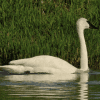 Over halfway up I-15 in eastern Idaho lies one of the jewels of the American West, Camas NWR. It is largely glacially-formed kettle ponds with arid grassland on the edges, so an excellent diversity exists on its wildlife loop. Additionally, many songbirds inhabit the cottonwoods along an old creek bed, albeit ditched. It and Targhe National Forest are great Idaho stops for birders and nature enthusiasts alike, on their way from Utah to Montana.
Over halfway up I-15 in eastern Idaho lies one of the jewels of the American West, Camas NWR. It is largely glacially-formed kettle ponds with arid grassland on the edges, so an excellent diversity exists on its wildlife loop. Additionally, many songbirds inhabit the cottonwoods along an old creek bed, albeit ditched. It and Targhe National Forest are great Idaho stops for birders and nature enthusiasts alike, on their way from Utah to Montana.
Liz and I are perfecting the Plains-Rockies trip for next year, exploring several new places each day for gems. We are stationed in Malta, with nothing between us and Canada except McCown’s Longspurs and Ferruginous Hawks.
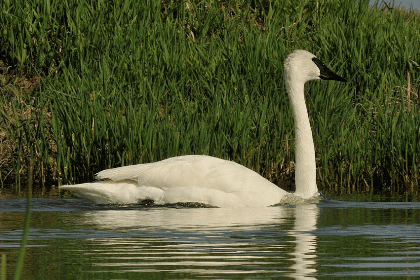
Camas NWR is famous for nesting Trumpeter Swans and has many prairie pot holes for waterfowl of many species to breed. These are kettle ponds dug out by the ice sheets that scoured the North American landscape around 16,000 years ago. Much of the way our continent appears is because of this glacial epoch. Camas is about 2/3 the way up I-15 in the eastern half of Idaho. Trumpeters were once very rare but with protection have made a great recovery. They have many chicks and with protection will often raise several to adulthood. They lack the yellow bill-spot of the Tundra Swan and the curved neck of the Mute Swan. They are North America’s heaviest wild bird and are now populating southern & central Alaska.
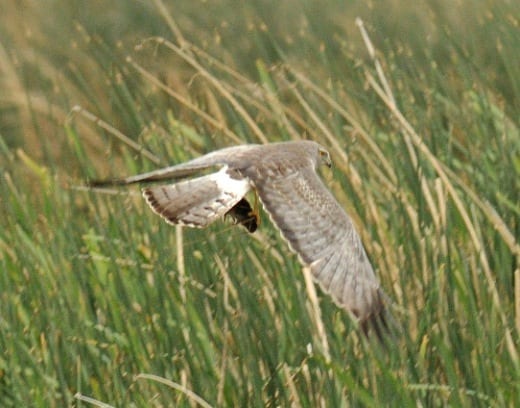
Two rodent-eating predators with similar niches are the Northern Harrier (male above) and the Short-eared Owl (below). Both have excellent hearing and the harrier actually has a rat in his talons. This species of owl can hunt diurnally, as many of their kind nest in the 24-hour daylight of the North Tundra. They have a unique flight style, like a butterfly, but we also noticed courting male Lark Buntings flopping along in a similar way.
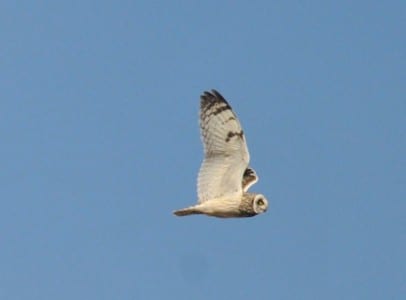
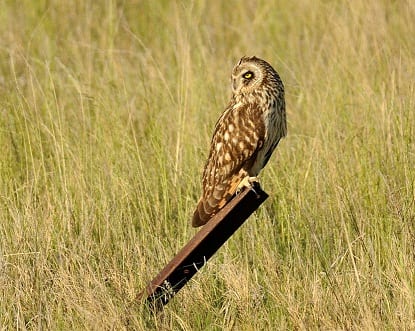
Here is a study of the Short-eared Owl utilizing an old post for low-energy hunting. Structures like this tip the balance of power to the side of the predator as grasslands aren’t supposed to have them. This is why our coastal bluestem in Texas needs to get rid of tallow trees and other bushes that fire should have kept at bay. Poor flying songbirds like Le Conte’s Sparrows and wrens are losing the battle with sharpies and Merlins.
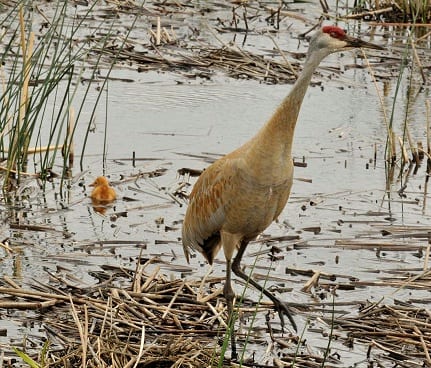
Sandhill Cranes breed over much of North America in suitable habitat. In much of their range they become quite brownish, perhaps stained with tannic acid in the water. It is amazing to see the size difference between this adult and the day-old chick behind it. But with faith like a mustard seed the little tyke will be its parent’s size in six weeks, and follow them around the first winter.
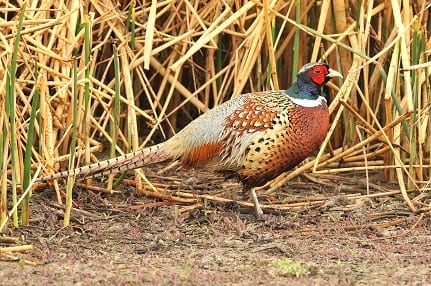
Pheasants are an Asian group of galliforms* with long tails and wild colors. These Ring-necked Pheasants are introduced many years ago and are a favorite of hunters in the Plains. Females are virtually invisible, like some other galliforms and teach their chicks the art of camouflage. And like ducks, where the males are gaudy colored, these dads stay away from the chicks, not wanting to draw predators near. *Galliformes is the order of quail-like birds, including grouse, turkeys and a few more.
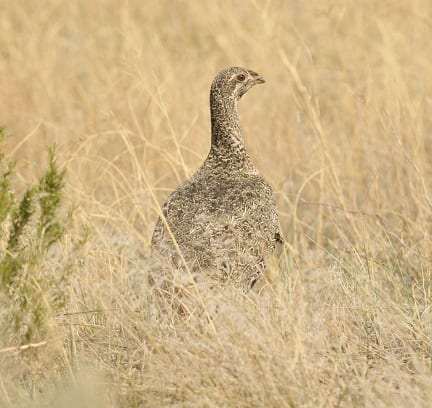
One of our largest galliforms is the Greater Sage Grouse, a species that lives almost exclusively on the nutritious leaves of the sage bushes. The old “Sage Grouse” was recently split, with the above species wide-ranging and another one, the Gunnison Sage Grouse, just found in a tiny portion of central Colorado.
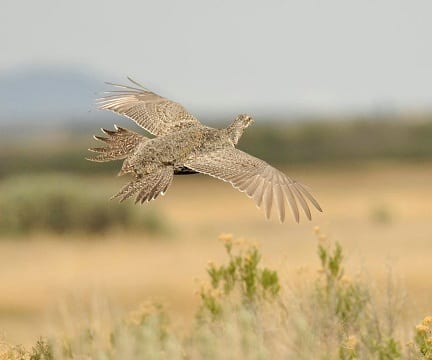
Hunters enjoy shooting these birds in the air (or trying to) and so do bird photographers: The sage hen blasted off like a rocket but Nike (the name I gave my camera) was all over it. She’s lost her central retrices but you can see the black belly – barely. All galliforms have rounded wings for fast flight, a must when you taste delicious to predators. Sage grouse (of both species) are kinda small-headed, too, and a little odd-looking with those proportions.
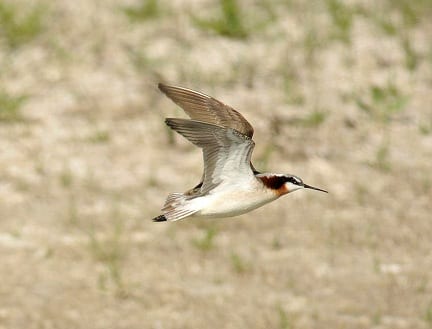
Wilson’s Phalaropes breed at Camas, and in many wetlands in the Northern Great Plains. They have a needle-like bill for sucking up plankton and insect larvae and like all shorebirds, are great fliers. This is the female, much prettier than the dull male. This particular angle allows you to see the axillaries (wing pits) and under-wing coverts. Note the white upper-tail coverts (rump).
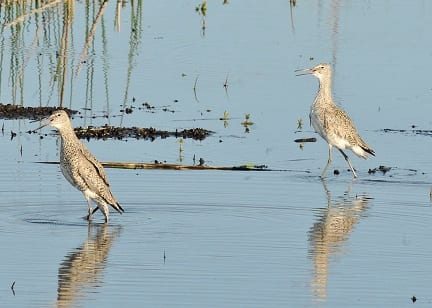
This pair of Western Willets is already territorial even though they haven’t laid eggs yet. You can see they don’t look quite like the Eastern Willets that breed on the Gulf (or Atlantic) Coasts, and seem to be headed toward a different species. The erect posture and lowered tail indicates territorial display and pair bonding. This is the “species” which winters on the Gulf & Atlantic Coasts, mostly eating fish and swimming crustaceans. I’d give real money to know what they eat on their breeding grounds.
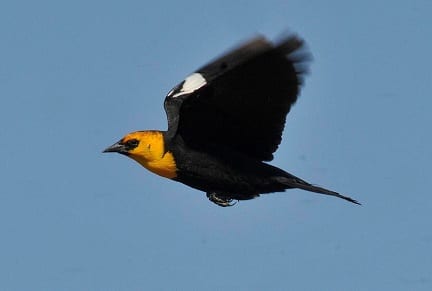
Yellow-headed Blackbirds are one of many species with white in the expendable part of their plumage (wings and/or tail) and predators like hawks are apt to go for those bright colors than the less flashy body feathers. They serve a double function sometimes as a courtship display and this species looks really good flitting around their prospective mates. But they also sit and court: Here is one contorting his body and making sounds I could only describe as jackass-like groans. Females dig it, though, and that’s the name of the game. Many blackbirds lack the color of this species and their entire courtship is limited to contortions and strange sounds. BTW, their scientific name is Xanthocephalus xanthocephalus, or the “yellow-headed yellow head.” We get these occasionally in Texas in the migration.
”]
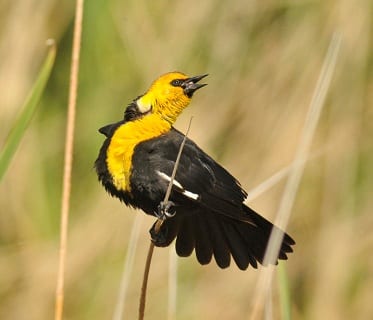
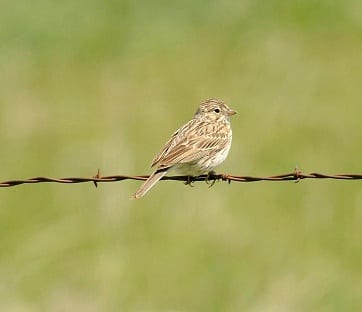
Sparrows are always tough and often a favorite of us birders who think we are better than we really are. But let me show you some subtleties that would allow you to identify this species. You may wanna compare it to the picture in a field guide, although this western form is a bit paler and less marked than the more eastern ones. It is a Vesper Sparrow, and here are the five field marks I use, depending on the angle: 1) Faint eye-ring; 2) White outer tail feathers; 3) Reddish patch on the bend of the wing; 4) Small, pinkish bill; and, 5) Very long toes.
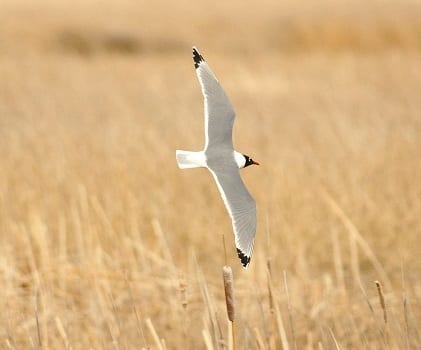
Franklin’s Gulls are one of those lucky birds that can feed as easily around water as they can over dry land. The red on its thin bill is typical of high breeding plumage, quite like that of our ubiquitous Laughing Gull along the coast. In fact, when they mix in the migration they can be a challenge to separate.
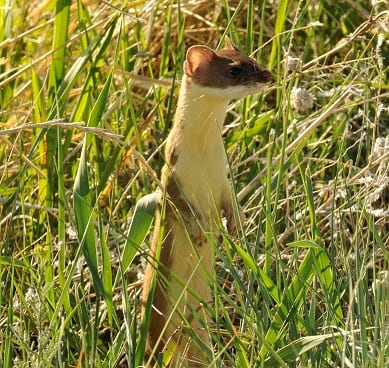
A seldom-seen mammal of the American West is the weasel. With a longer body than other small mammals they can follow prey down their holes and overpower them with their length. Favorites include ground squirrels but birds and their eggs supplement their diet. They stand erect, like many other mammals, looking more like a stick than an animal. Hawks do the same thing, causing unaware food items to mistake them (fatally) for limbs and poles.

 Posted in
Posted in 
























Whoa, superb web site structure! The way very long will you be blogging and site-building regarding? you will be making posting glimpse uncomplicated. The full search of your website is astounding, plus the material!